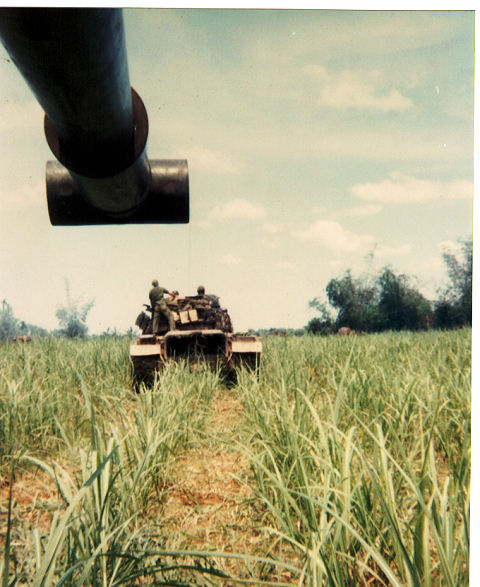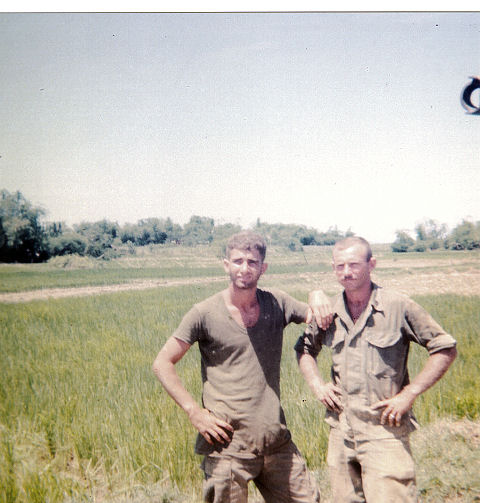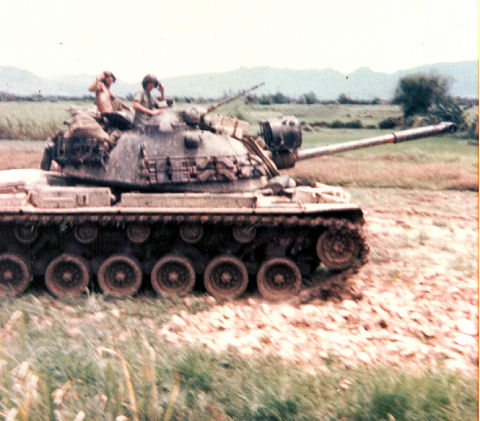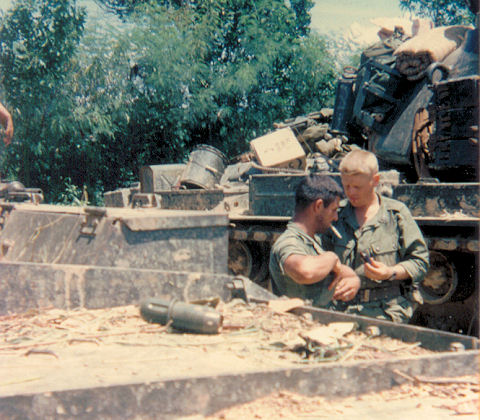|
After we medivac the wounded as a result of these VC snipers we got the word to move out. It was not long when we found our self directly on top of (25 to 30 meters) a large VC unit. I was searching and traversing the turret in order to find a clear target to unload a canister round when SSgt Thomas (Turby) yelled, "gooks 12:00!" I swung the turret around and all I could see were VC running frantically around firing weapons. Without an order to fire, the main gun recoiled and approx 1300 30 Cal. pellets were on their way to the VC location. Without waiting and while Truby (SSgt Thomas) was firing the copula mounted 50 cal. machine gun at the same time giving his fire commands to me and telling the loader to insert another canister. By this time I began to distinguish more clear VC targets. These guys were will prepare, well armed and it was obvious that we had driven directly into an ambush. There were so many close VC that their movement was not hard to detect. I felt that I couldn't fire fast enough to cover the threat. I heard SSgt McCormick (Jerry) over the radio yelling several times "Scratch my back the are gooks all over me!" As I was swung the turret in his direction which was to our right front I could clearly see a few gooks take a bursts from Jerry's Copula mounted 50 Cal. machine gun. It downed one VC and took off the left arm of another gook turning him around and put him to the ground, but to my amazement and disbelief this guy gets up and starts running down a trench with my tracers pouring into his nap sack. As A-35 came into my view I could see why Jerry's call's were filled with total anxiety, there were several VC attempting to lay charges on top of his tank without a command I sprayed A-35 with 4 to 5 healthy burst of coax (30 Cal.) machine gun. About this time I am thinking this is why I came to Vietnam, this is what it is all about. I felt we had the upper hand in this fire fight that was supposed to be an ambush, and the source of our demise. Being young and dumb, I was thinking one dimensional and blindly. We were barely staying afloat and Jerry and Trudy knew it. As I was directing my attention back to my sector of responsibility I saw some VC attempting to fire a RPG at us and Trudy must have seen the same picture because by the time he said "RPG" I had let the canister round go and when the smoke cleared I was already focusing back on the same area with the infinitive sight pressing the red triggers and the gunners controls sweeping the VC trench line with 30 cal.. At some point in time I began to think there are more of these gooks than we can kill, "where the hell are the grunts"? I was hearing explosions on and near our tank, then Jerry (TC A-35) came over the radio and said" Hey, let’s get the hell out of here. There are too many gooks here!" I began to wonder if there was something going on that I didn't comprehend. I said to Turby, "we got them were we want them (that was a very stupid observation on my part) we can't leave now!” Jerry was adamant about leaving, and about this time Trudy calls back to 9th Marines Company CO to asking where they were, and that we need their support. It turns out that the grunts had stop again due to more Marine's getting wounded and in the confusion had forgot to inform their tank section to stop. We were two tanks several hundred meters ahead of the grunts and being surrounded by at least a company size VC unit. Sgt Kulick, not being an experienced loader was doing a great job keeping the 30 Cal. firing and the main gun fed with rounds. I can remember asking for another canister and he throw in a WP, but anything down range at this point severed the purpose. About this Time I heard what could only be described as someone hitting the side of the turret with a sledge hammer. There was no explosion however. I thought that was awful strange at that time. I continued to put canister and 30 cal. along the tree line and trenches seeing many VC taking hits, but continuing to fire back at us until they received additional bursts of 50 and 30 Cal. Jerry called again overly excited to Trudy and insisted that we pull back and call in for supporting fire, and shortly thereafter the grunt Actual called and said he has fast movers coming in with Nape and 500 pounders so, we need to exit the area. As we backed out I continued to lay down covering fire for Jerry because his tank was well forward of ours, and the gooks were trying to out flank him on his left. We moved no more than 50 yards back when the entire front of our vision was engulfed in flames of red and black smoke. The shock of 500 pound bombs that close shook the vehicle. After several passes by our air support dropping napalm and bombs we stop receiving fire and the only sound that was heard was that of things burning. You could smell the horrible stench of burning flesh in the air. By this time the grunts had made it to our position. A short while later the order to move out was given and we moved through the area that had previously being occupied by the VC Company. We drove over the trenches and set up a 360 on the other side. After assessment of what had just happen the gravity of the event started to set in and I became suddenly physically and mentally exhausted. There were many VC dead and only two wounded VC were found, one being a young woman. She was brought to my tank along with another VC man and they both had their arms tied behind their backs. I was asked to watch them until a chopper that was in coming could pick them up. The grunts picked them up and sat them on the back of my tank. Turby was checking out A-34 for hits and discovered an unexploded anti-tank round on our left front finder. That was the sledge hammer sound I had heard during the ambush. My attention focused back on the two VC that were occupying the back of my tank. I noticed the woman staring at me with hatred in her eyes that I have never seen before or since. The man was lying down by this time and crying from the pain of his wounds, but as I looked back at the VC female I noticed that she was wounded worst than him, but she was not making a sound. She had bad burns and deep shrapnel holes in several places. I asked her with a gesture of my canteen if she wanted some water, but she just continued to starred defiantly at me and I knew if she had the opportunity and the resources she would cut my throat, or worst. The chopper came in and the POW's were taken off my hands. We all decided to quickly put down some C-rats. As we were sitting together (very stupid thing to do) on a rice paddy dike eating chow and talking about the morning contact, snipers opened up on us along with bursts from automatic weapons fire. Another corpsman was hit. Where they came from was a mystery. Sgt Kulick and I both just made a mad dash for A-34 as round kicked up around us. I still remember to this day that I leap from the ground on a dead run to the finders and into the turret without using the tank to pull myself up. We were both in the tank and Sgt Kulick said, “I’m hit!" His eyes were as big as oranges and he was holding his left arm. I quickly investigated his wound, but what I found was a hole in his left shirt sleeve and a red streak mark on his arm. After he realized this we both laughed with a bit of anxiety. (A few months later I was told that Sgt Kulick experienced a mental breakdown and started shooting at our own grunts with a 50 Cal machine gun thinking they were NVA. He was sent back to the states for treatment. I sure hope he has found the help he needed. He was a friend and a good man. It's a wonder that more of us haven't lost grip! I know I have more than my share of anxiety and other facets of relate physiological problems related to my time spent in VN.) Turby and Holmes finally made it to the tank and we began to attempt to fine the source of the incoming fire. A few rounds of strategically placed 90mm HE T-91 in a few bunkers silenced most of the automatic weapons fire, but the sniper fire continued. A while later we made a push to renew contact with the remaining VC, but all we got in the next couple of hours was incoming mortars and more sniper fire. A few more Marines were wounded and we all were scared, but also fluctuated and getting more pissed off. By late afternoon and with precisely laid arty fire and air strikes called in by the grunt CO we managed to finally weep through this village which lay in our path and to the banks of a river next to it. The only thing left alive in that village was a couple of pigs and a wounded old woman. I heard Turby say over the intercom, "Where the Hell did the gooks go, they have just disappeared!" We set up a 360 and A-34's sector of responsibility was overlooking the river. As I got out of my tank a grunt Sgt came over and asked if he could borrow my 45 Cal. pistol. I thought he was going to check out a hole, without hesitating I gave it to him already loaded. He just did seem very happy. Then he turned and walked down a trail a short distance. I heard one shot and within a minute he came back with my pistol and said, "That old bitch want feed any more gooks!" I am still dumb-founded, shocked and stunned to this day, not only that he shot that old woman but he used my pistol. Strangely enough at that time I knew why he did it, anger had controlled his actions, and he wasn't thinking clearly at the time. The marines even shot the pigs. Over the next few days we were ordered to blow any boats to hell coming down the river. Our tank accounted for destroying nine and no telling how many people? We lost three Corpsman that day and several Marines either killed or wounded. The enemy took us on and lost a lot of people in the process. How they could just disappear, melt away is a credit to them. If we could have cornered them that day more death would have been evident on both sides. I was told after returning from Operation Liberty that when we pulled back from the ambush site and after the air strikes ended, an entire squad of VC with RPGs was found dead from napalm trying to oust flank A-34 my tank, so in hindsight SSgt. Jerry McCormick's concerns and anxiety was warranted, and he deserves full credit for not only saving his tank crew that day but mine too!
USMC After Action Report Operation Liberty With the surrender of the struggle Forces at Da Nang and the restoration of some stability there, the 9th Marines once more renewed its offensive, coordinated with the South Vietnamese. On 2 June, Colonel Lap, who had replaced Colonel Yeu as the Quang Da Special commander, visited Colonel Simmons at his CP. The South Vietnamese commander wanted the 9th Marines to resume Country Fair operations in the five-village pacification area. He assured Simmons that at least one battalion from the 51st ARVN Regiment would be committed to the pacification campaign. following Lap's visit, Colonel Simmons revised portions of his previous orders. On 5 June, he ordered his battalions to renew County Fair operations with the Vietnamese and extended the deadline for the attainment of Phase Line Brown from 31 May to 20 June. At this juncture, General Kyle decided to transform the 9th Marines Ky Lam Campaign into a division-size offensive, involving "a conventional linear type attack of all forward units to push the front lines forward in a deliberate search of every hamlet in the zone. . . . " He divided the Da Nang TAOR into three sectors: the cleared, the semicleared, and the uncleared. The cleared, area formed an irregular arc around Da Nang Air Base, delineated by the South China Sea to the east, the Cau Do to the south, the foothills to the west, and the Cu De River to the north. Extending the arc outward from the cleared area boundary, the semi cleared sector reached the Thanh Quit River to the south, three to five kilometers into the high ground to the west and the Hai Van Pass to the north. The uncleared region consisted of the area between the La Tho-Thanh Quit Rivers and the banks of the ky Lam-Thu Bon. Phase Line Green, the final phase line, paralleled the latter two rivers. The 3d Marine Division commander ordered that only minimum forces be held in the rear and set 30 June as the target date for reaching Phase Line Green. Continuing arrival of marine reinforcements allowed General Kyle to make this all-out effort. On 28 May, the 1st MP Battalion arrived at Da Nang from the United States and relieved the 3d Battalion, 3d Marines of its airfield security mission. The 3d Battalion then returned to the operational control of its parent regiment, taking over the 3d Marines western TAOR. Colonel Harold A. Hayes, Jr. , who had relieved Colonel fisher on 16 April as 3d Marines commander, at last had command of all three of his battalions Other reinforcements were scheduled to arrive at Da Nang, or were already in place. Colonel Bryan B. Mitchell was slated to transfer his 1st Marines Headquarters from Chu Lai to Da Nang in June. In fact, two of his battalions had already moved by the end of May. The 3d Battalion, 1st Marines arrived at Da Nang on 22 May while the 1st Battalion arrived on 31 May. Both battalions were temporarily placed under operational control of the 9th Marines. The 3d Battalion became the regimental reserve; the 1st Battalion relieved the regiment's eastern flank battalion, the 2d Battalion, 4th Marines, which rejoined its parent regiment at Phu Bai. By mid-June General Kyle could expect to have three Marine infantry regiments consisting of eight battalion at Da Nang. He planned to reduce the extensive 9th Marines TAOR by assigning the 1st Marines to the eastern flank while the 3d Marines took over that part of the 9th Marines TAOR west of the Yen River. In effect, Kyle visualized a shoulder-to-shoulder advance to the Ky Lam. The operation, codenamed Liberty, was scheduled to begin on 7 June, with the 9th Marines bearing the brunt of the campaign in its initial stages. Colonel Simmons divided his TOAR into company-sized objective areas. His reserve battalion, the 3d Battalion, 1st Marines, was to concentrate on combined operations with ARVN and Vietnamese local forces in the five-village pacification region in the semicleared area. The 3d Battalion, 9th Marines was to continue its two-company holding action in the An Hoa region. All the remaining infantry companies were assigned tot he three forward battalions, the 1st Battalion, 1st Marines on the eastern flank, the 2d Battalion 9th Marines in the center, and the 1st Battalion 9th Marines on the western flank. Thus each forward battalion was to consist of five infantry companies instead of the usual four, with three companies deployed tot he front and two to the rear. The advancing battalions were to secure Route 4 by 20 June and reach the Ky Lam by the end of the month. Lieutenant Colonel Van D. Bell, Jr's 1st Battalion, 1st Marines, on the division's left, had its heaviest engagement just before Operation Liberty started. During the evening of 5 June, the battalion commander and his small mobile command group, embarked in three *Ontos, found themselves stalled on the northern fringes of Phong Ho, a hamlet 10,000 meters south of the Marble Mountain Air Facility and in an area "noted for their hostility toward ARVN soldiers and their allies." Bell's vehicle had run out of gas and the group had just been resupplied by helicopter. As the aircraft took off for the return trip to Marble Mountain, VC weapons from positions approximately 1,000 meters to the southwest opened fire. Using his command group with its *Ontos as a blocking unit, Lieutenant Colonel Bell ordered reinforcements from his Company B, supported by LVTs and tanks, brought up from the south of Phong Ho. According to the battalion commander, "the result was a sound thrashing of the VC" with 11 dead enemy left on the battlefield and a number of captured weapons. Bell remembered several years afterward, "This area was never pacified and later was leveled, and the villagers removed and relocated." *The Ontos was a full-tracked, light armoured, mobile carried mounting six 106mm recoilless rifles, four .50 caliber spotting rifles, and one .30 caliber machine gun. It had a crew of three and was the primary weapon of the antitank battalion. On 7 June Operation Liberty began with heavy preparatory artillery fires. Marine artillery neutralized 35 objective areas in front of the advancing infantry. Initially, the enemy countered the Marine offensive with only small arms fire and mines. The mines were the more deadly of the two. The most significant mine incident occurred on 11 June in the 9th Marines central sector. Captain Carl A. Reckewell's Company F, 2d Battalion, 9th Marines walked into a large minefield in a grassy plot just south of the La Tho River. Two detonations killed three Marines and wounded 21. While the wounded were being evacuated, four to five additional explosions occurred and the grass caught fire, but fortunately there were no further Marine casualties. The following day, the artillery fired a destruction mission which caused seven secondary explosions in that same field. On 15 June, the division completed its planned realignment of regiments in the TAOR. Colonel Mitchell assumed operational control of his two 1st Marines battalion and took over responsibility for the division's eastern flank from the 9th Marines. With a corresponding reduction in the western sector, the 9th Marines' TOAR now consisted of only 134 square miles, the regiment having given away nearly 100 square miles in the exchange. With the adjustment of forces and sectors, the 3d Marine Division continued its "scrubbing" actions in Operation Liberty. The only serious enemy opposition occurred in the 9th Marines zone of action. On 18 June, Company C, 9th Marines, operating 2,000 meters south of Dai Loc, came under heavy mortar and small arms fire, suffering eight wounded. The company asked for supporting air and artillery which ended the enemy resistance. Lieutenant Colonel Donahue's 2d Battalion, 9th Marines underwent a similar attack on 22 June in the hamlet of La Hoa, immediately east of the railroad and 4,000 meters north of the Ky Lam. Marines once more called upon supporting arms, including naval gunfire from the destroyer USS Marton (DD 948), to silence the enemy. According to U.S. Navy historians, "Between four and nine ships including destroyers, cruisers, and rocket ships were available for gunfire support in Vietnam at any one time and more than half the missions supported Marines in I Corps." NHD, Comments on draft MS, dtd 19June78 (Vietnam Comment file). By the end of the month, all three Marine regiments reached Phase Line Green and the operation ended. VC resistance to the Marines advance had been scattered and ineffective. The 9th Marines observed that the lack of major enemy resistance gave plausibility to the thesis that the momentum of Operation Liberty prevented them from gaining any degree of initiative and uprooted them "from what had been a relatively secure operating area." That regiment alone claimed to have recovered 40 square miles from the VC. The Marines were once more optimistic about pacifying the extensive Da Nang enclave. 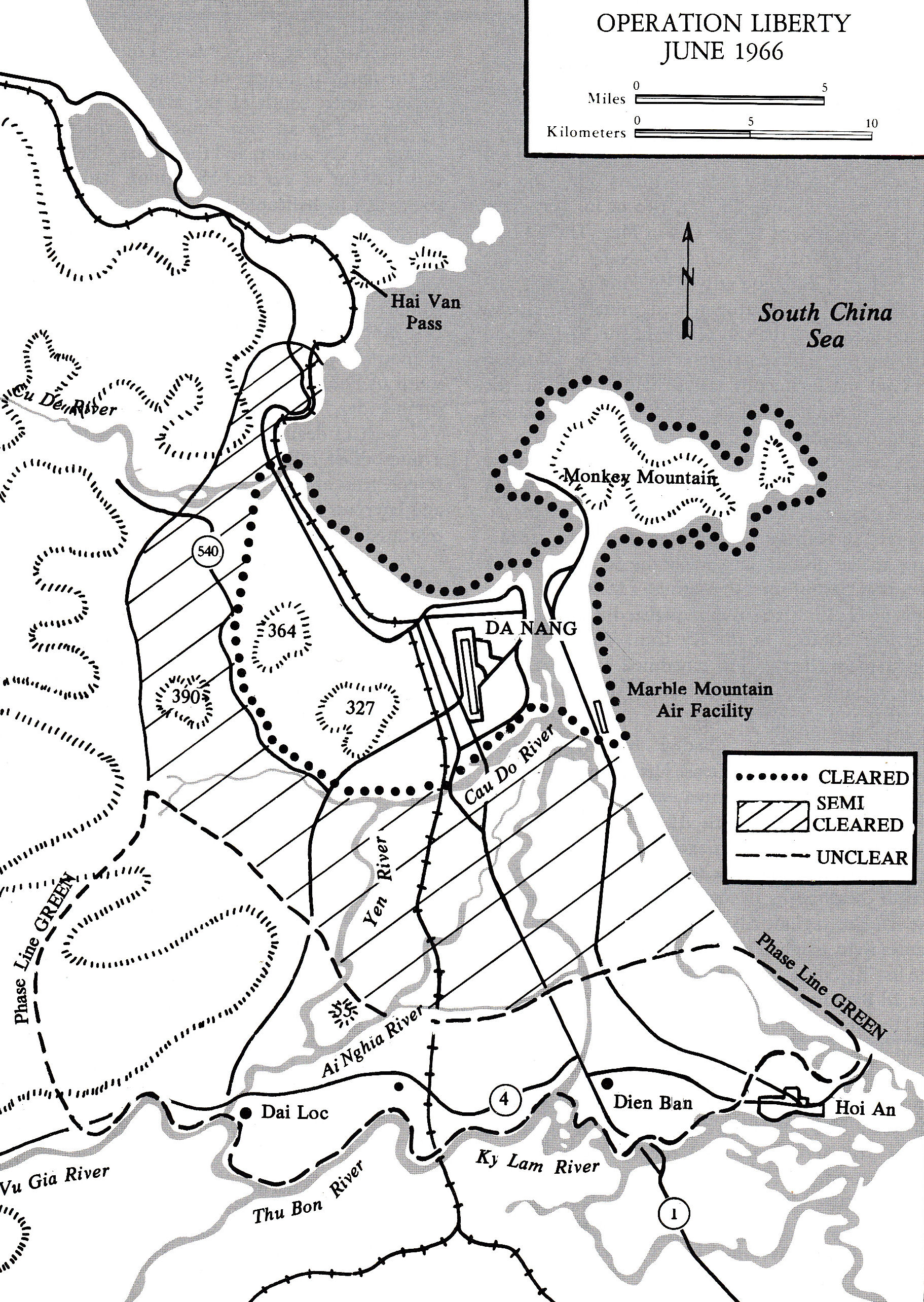 |
